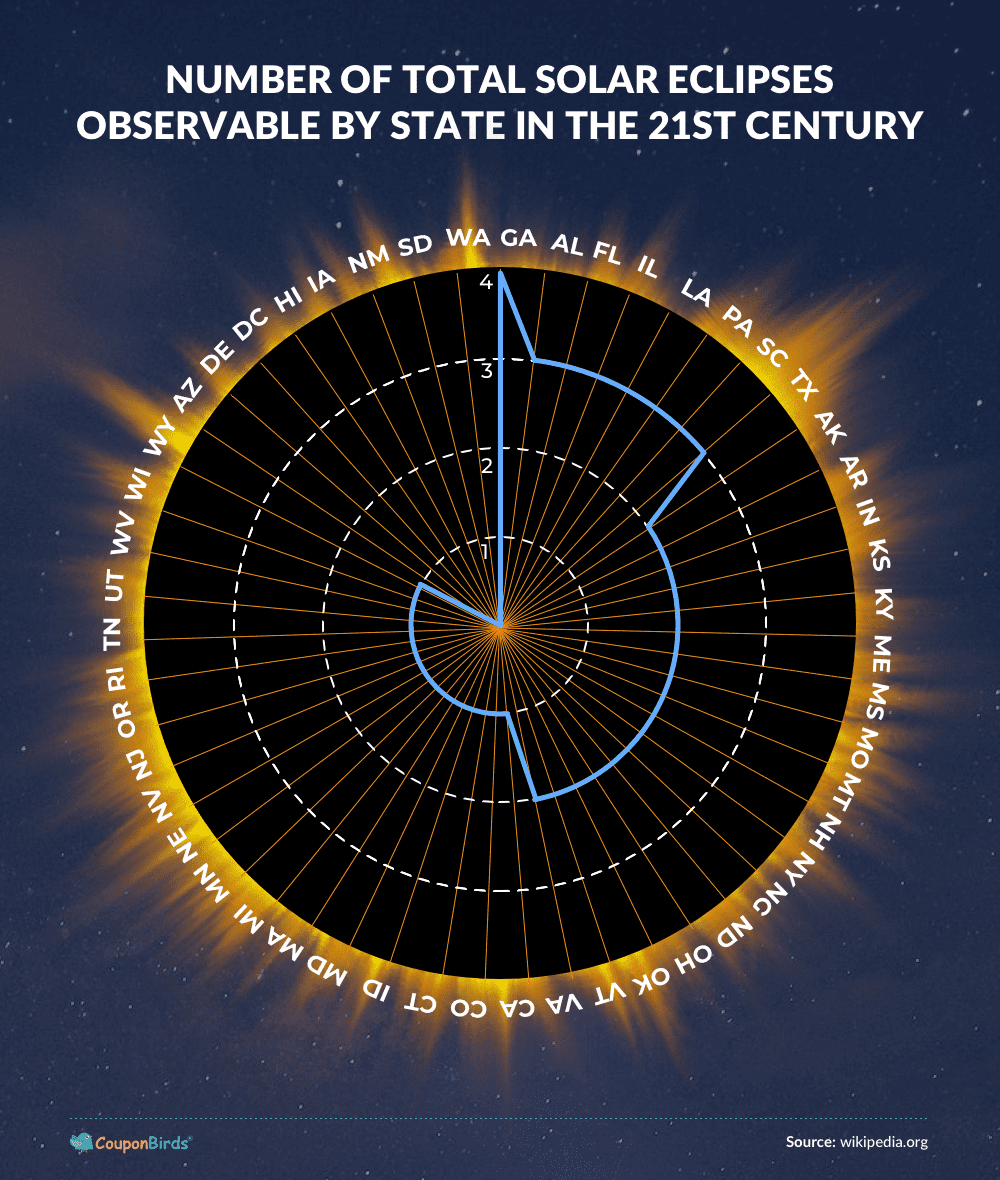In the vast universe, we often see mysterious celestial events. A solar eclipse occurs when the Sun, Moon, and Earth align, casting a shadow over parts of Earth. On April 8, 2024, the US will experience a total solar eclipse, covering 15 states from Texas to Maine. The next similar event will be in 2045, over 20 years from now. This 2024 eclipse is expected to attract millions of viewers. We have analyzed data on this eclipse, and our findings are as follows.
-
The recent total solar eclipse has attracted widespread attention. Google Trends have shown significant increases in growth multiples and keyword searches, almost double that of the most recent total solar eclipse, which is on Aug 21, 2017.
-
Eight cities are recommended as prime spots to view the eclipse, chosen based on the viewable percentage index and duration of totality.
-
Georgia is the luckiest state for viewing total solar eclipses in the 21st century with four occurrences, while 8 states won't have the opportunity to witness one at all.
-
Compliant solar eclipse glasses are required for safe viewing.
The Total Solar Eclipse on April 8, 2024 Has Captured Broad Attention
This total solar eclipse path will cover an area with 31.6 million people, which is 2.6 times that of 2017. Meanwhile, the duration of totality is also longer, with a maximum of 4 minutes and 26 seconds, compared to 2 minutes and 42 seconds in 2017. This makes the 2024 eclipse more noteworthy and deserving of observation.

There has been a notable increase in the term "Solar Eclipse" on Google Trends. The search term "Solar Eclipse" increased 20 times in search interest over a 90-day interval, compared to 10 times in 2017. From Semrush, the monthly search volume for "Solar Eclipse" on March 21, 2024 is 201,000, nearly double that of August 21, 2017 at 110,000.

Additionally, the top 5 states with search interest for "Solar Eclipse" are Vermont, Ohio, Indiana, Arkansas, and Maine, all located in the northeastern part of the eclipse path. These states have historically cloudier skies, raising concerns about viewability. People in these areas might worry about missing out on the spectacle, which contributes to their high interest in the solar eclipse.
Eight Cities Are Recommended as the Best Viewing Places
The North Carolina Institute for Climate Studies came up with an indicator of possibilities of viewing sunny weather on a specific day, called "viewable percentage index", and calculated the viewability for all the weather stations across the US on April 8th, 2024. We compiled data from weather stations along the path of the total solar eclipse and selected 8 optimal cities with the potential viewability greater than 50% and duration exceeding 3 minutes. A map has been created highlighting these eight recommended cities.

While these cities offer good potential for viewing the event, it is important to remember that weather conditions can change. To maximize your chance of a clear view, it is recommended to monitor the weather forecast closely in the days leading up to the eclipse and plan accordingly because the weather forecast within 5 days can ensure an accuracy of up to 90%.
Random Distribution of Total Solar Eclipses with Some States Being Luckier than Others in Terms of Visibility
In the 21st century, there will be 10 total solar eclipses that can be observed in the US. Georgia is the state with the most opportunities, with four occurrences. On the other hand, eight states will not experience any. Additionally, Delaware and the District of Columbus may not witness even an annular solar eclipse.

Compliant Solar Eclipse Glasses Are Required for Safe Viewing
When viewing a solar eclipse, it is crucial to wear safety glasses to protect your eyes. Directly looking at the sun without proper protection, even briefly, may cause permanent damage to your retina. It is recommended to wear specialized eclipse glasses or hand-held solar viewers with filters that allow only 0.001% to 0.00005% of the visible light to pass through. Regular sunglasses are not suitable for directly viewing the sun.
As April 8, 2024 is approaching, there has been an increase in counterfeit eclipse glasses on the market. Ensure that the eclipse glasses you purchase are from a brand listed by the American Astronomical Society (AAS) and complies with ISO 12312-2 international standards. We selected several compliant glasses from Amazon's top sellers for your reference.

Methodology
We analyzed the popularity of the total solar eclipse by comparing search term interest data from Google Trends and monthly search volume data from Semrush for 2017 and 2024.
To recommend the best places to view the solar eclipse, we utilized weather observation station data from the North Carolina Climate Institute to evaluate eclipse duration and viewable percentage index for cities along the path of totality.
Then, we calculate the number of total solar eclipses visible in each state during the 21st century using data from Wikipedia to identify the luckiest and unluckiest states for observing total solar eclipses.
Finally, we selected solar eclipse glasses from Amazon's top sellers and ensured they were sold by reputable stores, with manufacturers that meet the standards set by the American Astronomical Society.

This work is licensed under a Creative Commons Attribution-ShareAlike 4.0 International License.


